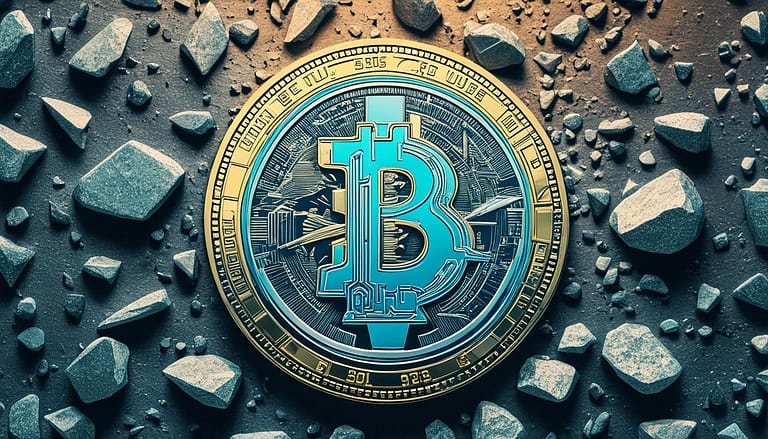What is Solana?
Delving into the world of cryptocurrencies, a common question arises: what is Solana? At its core, Solana represents a groundbreaking Solana blockchain platform acclaimed for its decentralized nature and staggering capacity to scale, offering a foundation for a multitude of applications to flourish. Conceived in 2017 and nurtured by the Solana Foundation in Geneva, with the technical backbone architected by the diligent minds at Solana Labs in San Francisco, it has rapidly become a cornerstone in the cryptocurrency community. The prowess of Solana cryptocurrency lies in its ability to conduct transactions expeditiously, complemented by minuscule fees—a stark contrast to its peers like Ethereum. This prodigious blend of speed and affordability led to the Solana token (SOL) witnessing unprecedented growth, even touching a market capitalization zenith of over $75 billion during its heyday in 2021. However, it was not impervious to the market’s ebbs and flows of 2022, mirroring the volatility inherent to the cryptocurrency landscape.
Key Takeaways
- The Solana blockchain is renowned for its high scalability and low transaction fees.
- Solana has experienced meteoric growth, signifying its market strength despite the volatility.
- Engineered by Solana Labs, the platform is underpinned by innovative technology.
- The SOL token emerged as a front-runner in the cryptocurrency market.
- Even faced with market downturns, Solana has shown a tenacious ability to rebound.
- Solana’s unique infrastructure has set a new precedent for speed within blockchain ecosystems.
The Fundamentals of Solana
Embedded within the innovative fabric of the cryptocurrency landscape, the Solana blockchain emerges as a leading-edge technology, firmly grounded by the Solana Foundation and engineered towards higher scalability and efficiency by Solana Labs.
Origins and Development of Solana
It was the foresight of Anatoly Yakovenko that propelled Solana into the vanguard of blockchain evolution. His deft application of distributed systems expertise, honed at Qualcomm, ushered in a revolutionary chapter where network synchronization was accelerated to unprecedented speeds, propelling Solana’s market traction and making it a competitor only hindered by the limits of bandwidth. The advent of Solana is a testament to the ingenious strides taken in blockchain innovation, with every algorithmic adjustment being a crucial stitch in its robust digital fabric.
Solana’s Market Performance and Adoption
Marked by a rollercoaster trajectory, the Solana price and its market capitalization have seen dramatic shifts. With a meteoric ascent translating to a near 12,000% increase in 2021, the value of the Solana token was subjected to the industry’s infamous volatility, leading to a decline that reflected the broader market trends. Despite this, Solana exhibited a recovery that reflects its unyielding stature in the marketplace, regaining approximately half of its peak Solana market capitalization, and continues to solidify its relevance among cryptocurrency aficionados and investors alike.
Understanding Solana’s Proof-of-Stake and Proof-of-History Mechanisms
At the intersection of speed and security, Solana’s hybrid consensus model marries the efficiency of proof-of-stake (PoS) with the temporal precision of proof-of-history (PoH). This duality of mechanisms democratically empowers validators to partake in Solana staking while also leveraging an innovative means to chart transaction sequences, culminating in a blockchain that harnesses both speed and cost-effectiveness—notably distinguishing itself from legacy PoS systems.
| Feature | Description | Impact |
|---|---|---|
| Anatoly Yakovenko’s Innovation | Architectural improvements introduced by Solana’s co-founder. | Greatly optimized synchronization, leading to speed increases. |
| SOL Market Performance | Volatility patterns in price and market capitalization. | Indication of robust resilience and recovery within the crypto market. |
| Consensus Model | Hybrid system combining PoS and PoH. | Enhanced speed and reduced costs in transaction validation. |
How Solana Enhances Blockchain Speed and Efficiency
In the dynamically evolving realm of cryptocurrencies, the Solana blockchain has emerged as a technological beacon, distinguished for its extraordinary performance, scalability, and support for decentralized applications. Leveraging a suite of advanced algorithms and architectural innovations, Solana stands out with a promise to fundamentally transform the throughput of blockchain technology.
Solana’s Transactions Per Second: A key performance indicator for blockchain platforms is the rate of transactions they can process. Solana is renowned for its staggering potential, with the capacity to handle up to 710,000 transactions per second on a standard gigabit network. This performance metric is a testament to the network’s well-engineered protocol stack and its support for high-frequency, high-volume use cases.
Scalability of Solana: Scalability is perhaps the most significant feat Solana offers the world of decentralized technologies. This unprecedented level of scalability is not just a number—it’s a paradigm shift, enabling the support of large-scale decentralized applications and complex smart contract executions without the dreaded network congestion and exorbitant fees that presently plague many blockchain networks.
This level of throughput is achieved through a combination of unique technologies such as the proof-of-history (PoH) consensus combined with the network’s proof-of-stake (PoS) model, which together enhance the overall efficiency of the network.
Solana’s proof-of-history consensus mechanism records time between transactions, allowing validators to quickly and securely add new entries to the blockchain – a pioneering approach that proves to be a cornerstone for its high throughput capacity.
Support for Decentralized Applications: Solana’s inherent ability to process transactions rapidly and at scale makes it an ideal foundation for building and hosting decentralized applications (dApps). With its robust infrastructure, developers can create dApps that are not only fast and reliable but also capable of catering to a multitude of users and transactions concurrently—visions of a truly scalable decentralized future seem increasingly achievable on Solana’s network.
Below is a comparative overview of Solana’s performance metrics:
| Performance Metric | Value | Impact |
|---|---|---|
| Transactions per Second | Up to 710,000 | Drastically reduces network congestion |
| Consensus Mechanism | Proof-of-History | Enables faster block times with greater security |
| Network Scalability | High | Supports growth of decentralized applications |
As we peer into the future of blockchain economies, it is evident that platforms like Solana are laying down the rails for a more efficient, scalable, and user-friendly ecosystem. Its exceptional metrics and dedicated support for dApps not only push the benchmarks for what blockchains are capable of but also inspire a new wave of decentralized innovations across the global tech landscape.
Solana vs Ethereum: A Comparative Analysis
The blockchain landscape is home to numerous innovative platforms, each with unique attributes and capabilities. Two leading blockchains that have garnered significant attention are Solana and Ethereum. Both have evolved considerably and are often compared by those interested in smart contract development, decentralized finance (DeFi), and non-fungible tokens (NFTs). Let’s delve into the nuances of each platform, particularly focusing on their smart contract capabilities, consensus mechanisms, transaction speeds, and recent developments.
Smart Contract Capabilities
Smart contracts are the cornerstone for complex applications in the Solana ecosystem as well as in Ethereum’s. These self-executing contracts weave essential logic into blockchain transactions, underpinning the flourishing DeFi sector and the burgeoning NFT markets. Both platforms enable developers to create decentralized applications (dApps), but the key differentiator lies within their performance and utilization of technology.
Consensus Mechanisms and Transaction Speeds
A pivotal aspect of any blockchain network is its consensus mechanism, which ensures transactions are securely and efficiently validated. Solana employs a unique Solana consensus mechanism combining proof-of-history (PoH) with proof-of-stake (PoS), which has been instrumental in achieving impressive transaction speeds and standout scalability. Meanwhile, Ethereum has traditionally operated on a proof-of-work (PoW) model but is transitioning to PoS, anticipating better scalability and energy efficiency through future Ethereum upgrades.
| Feature | Solana | Ethereum |
|---|---|---|
| Consensus Mechanism | Proof-of-History (PoH) / Proof-of-Stake (PoS) | Proof-of-Work (PoW) transitioning to Proof-of-Stake (PoS) |
| Transaction Speeds | 2,700 TPS | 15 TPS |
| Transaction Cost | $0.00025 per transaction | Varies, generally higher |
| Smart Contract Language | Rust, C, C++ | Solidity, Vyper |
Recent Ethereum Upgrades and Impact on Solana
Ethereum’s advancements, particularly the long-awaited upgrades to address concerns about blockchain scalability, have caused ripples throughout the crypto world. With initiatives like the introduction of sharding on the horizon, Ethereum is poised to markedly improve its performance metrics. These developments beg the question of how the Solana ecosystem will adapt and respond to maintain its competitive edge.
Is Solana’s superior transaction throughput and lower cost structure enough to sustain its ascendency in the face of Ethereum’s upgrades? This is the query at the forefront of the debate on blockchain scalability and the future prospects of these two behemoths.
Anatoly Yakovenko: The Brain Behind Solana
The innovative strides in the blockchain industry are often propelled by remarkable individuals whose visions transcend the conventional. One such luminary is Anatoly Yakovenko, the Solana co-founder, whose background in distributed systems catalyzed the creation of the groundbreaking proof-of-history concept. His experience as an engineer at Qualcomm laid the groundwork for a technology with the potential to redefine blockchain efficiency and speed.
Yakovenko’s contribution to Solana is not just in its underpinning technology but also in establishing a vision that has placed Solana at the vanguard of blockchain development. The proof-of-history mechanism is a testament to his ingenuity, showing the world that it’s possible to achieve higher throughput and reliability in blockchain networks.
A concise overview of Anatoly Yakovenko’s contributions to the Solana blockchain is delivered in the table below:
| Contribution | Impact on Solana |
|---|---|
| Implementation of Proof-of-History | Enabled faster transaction processing and improved network speed |
| Expertise in Distributed Systems | Applied advanced engineering principles to blockchain technology from his Qualcomm tenure |
| Leadership and Forethought | Guided Solana’s strategic direction towards becoming a leader in scalable blockchain solutions |
Yakovenko’s vision and leadership illustrate that innovative technology coupled with determined guidance can lead to significant advancements in the field of blockchain. Solana’s ascent to prominence is inextricable from his pioneering spirit and technical insight. As the blockchain arena evolves, Yakovenko’s role as the Solana co-founder will no doubt continue to attract attention from industry experts and crypto aficionados alike.
Exploring the Technical Infrastructure of Solana
Delving into the nuts and bolts of Solana’s robust framework reveals a well-architected system poised to redefine blockchain efficiency and security. Central to this architecture are the revolutionary strategies for validating transactions and managing the digital assets over its network. The evolution of Solana’s infrastructure demonstrates not only a commitment to sustaining high-speed transactions but also upholding stringent security to safeguard the blockchain’s integrity.
Validator Clusters and Network Security
Solana’s innovative take on blockchain security hinges on the implementation of validator clusters. These clusters are an aggregation of validators that work in concert, differing markedly from the standard single validator nodes. By employing a collaborative approach to validating transactions, Solana enhances the robustness of network security. This collective validation not only solidifies the trust within the network but also bolsters its capacity to manage a high throughput of transactions, ensuring that Solana validator clusters are at the forefront of secure transaction processing.
Breakthroughs in Transaction Handling Abilities
The prowess of Solana’s transaction handling is magnified by its groundbreaking tokenization standard, the SPL Token. Mirroring the well-acknowledged ERC-20 standard of Ethereum, the SPL Token provides a foundational layer for deploying and managing digital assets across the Solana ecosystem. This standard emerges as a beacon for developers and enterprises seeking to partake in the emerging token economy. Furthermore, Solana’s infrastructure has proven its scalability in cloud-based networks, sustaining extraordinary transaction speeds of up to 250,000 TPS during meticulous testing phases. These feats signal a new era in blockchain technology, with Solana leading the charge in both transaction handling and token standardization.
The Solana Token: Utility and Circulation
The Solana SOL token, a versatile cryptocurrency with considerable utility, powers the operations on the Solana blockchain. Fulfilling a dual role, the SOL token is necessary for both executing transactions and for staking, which aids in securing the network. A standout feature of the Solana blockchain is its ability to handle fractional amounts of SOL, making microtransactions feasible and inclusive.
These fractional units are known as lamports, an homage to the computer scientist Leslie Lamport. A lamport is the smallest subdivision of SOL, demonstrating Solana’s commitment to precision and flexibility in digital transactions. As of December 12, 2023, Solana reported a circulating supply of approximately 426 million SOL, highlighting the cryptocurrency’s growing presence and circulation in the digital economy.
Understanding Solana’s tokenomics is pivotal for both users and investors. To that end, the following table offers insight into the utility of SOL and its fractional counterpart, the lamport:
| SOL Token Utility | Description | Lamports Utility | Description |
|---|---|---|---|
| Transaction Fees | Users spend SOL to pay for transaction fees on the Solana network. | Microtransactions | Lamports enable the execution of transactions involving tiny fractions of SOL. |
| Staking | Holders can stake SOL to support network operations and earn rewards. | Granular Staking | Staking options are enhanced by the ability to stake small amounts via lamports. |
| Network Governance | SOL holders can participate in governance decisions, influencing the direction of the Solana network. | Account Balances | Account balances on the blockchain can reflect precise values down to single lamports. |
The utility of lamports extends beyond mere participation in the network to include detailed record-keeping, illustrating how even the minutest quantity of value does not go unnoticed. This meticulous approach to cryptocurrency denominations is a testament to Solana’s dedication to precision and inclusivity in digital finance.
The Expanding Solana Ecosystem
The Solana network is rapidly becoming a pivotal force in the realm of blockchain thanks to its dynamic ecosystem. It has become a fertile ground for a wide array of Solana NFT marketplaces and decentralized finance platforms, marking it as increasingly influential in the crypto industry.
NFT Marketplaces and DeFi Platforms on Solana
Marking a new era for digital assets and finance, Solana’s infrastructure boasts remarkable efficiency and capacity, making it a popular choice for developers. Industry players are taking note as Solana news often highlight fresh market entries, reinforcing its reputation among cryptocurrency companies. The high-speed blockchain is home to some of the most innovative and user-friendly NFT marketplaces and DeFi platforms available today.
In addition, the network’s versatility is evident as it enables a broad spectrum of applications, from gaming to finance, all benefiting from its remarkable throughput capabilities. This technological strength not only fosters creativity but provides tangible solutions for scalability challenges faced in the crypto space.
Relevance in the Greater Crypto Sphere
When discussing market position, Solana’s standings are commendable. As of late 2023, it holds the position of the sixth-largest cryptocurrency by market capitalization, a testament to its growing influence and adoption. The market position of Solana is not just a number—it’s a reflection of the trust and enthusiasm that the global community bestows upon this forward-looking network.
| Market Position | Unique Selling Points | Popular DApps Example |
|---|---|---|
| 6th in Market Capitalization | High Throughput, Low Transaction Costs | SolSea (NFT Marketplace) |
| Leadership in NFT and DeFi Space | Scalability and Efficiency | Serum (Decentralized Exchange) |
| Expanding User Base | Developer Support & Community Growth | Raydium (Automated Market Maker) |
The table above highlights Solana’s key strengths that contribute to its esteemed market position, solidifying its standing among the top-tier cryptocurrency companies. As the ecosystem continues to mature, it’s clear that Solana is not just maintaining relevance but is setting the pace for innovation across the greater crypto sphere.
Investing in Solana: Opportunities and Considerations
When it comes to diversifying investment portfolios, Solana investment emerges as a dynamic option amidst the surge of digital assets. Known for its rapid processing capabilities and innovative technology, Solana offers a multitude of investment avenues, from direct trading of SOL tokens to participating in network staking and exploring its burgeoning ecosystem of decentralized applications (DApps). However, such investment comes with its own set of complexities and uncertainties.
Investors inclined towards Solana are often those looking for growth and are willing to tolerate the inherent crypto risk involved. Cryptocurrencies, by their nature, are prone to significant price fluctuations which can result from market sentiment, technological advancements, regulatory news, or broader economic factors. This volatility underscores the importance of due diligence and the consideration of risk tolerance before adding cryptocurrencies like Solana to one’s financial portfolio.
Given its volatility and comparatively recent emergence, those looking at Solana for investment should seek the expertise of a financial advisor. Professional guidance can provide clarity on strategies tailored to individual financial goals and help navigate the complexities of blockchain-based investments. Aligning with a financial advisor is additionally beneficial for staying informed on the latest regulatory shifts and implications for tax obligations.
- Trading SOL on established cryptocurrency exchanges
- Staking SOL to support network security and earn rewards
- Investing in Solana-based DApps and platforms for potential returns
- Maintaining a diversified investment portfolio to mitigate risk
While investing offers the potential for rewarding returns, especially in an innovative platform like Solana, it is equally critical to recognize and prepare for possible downturns. In summary, consider investing in Solana if it aligns with your investment profile, after thorough research and professional financial advisement.
Current Solana Projects and Future Outlook
Bracing for impactful advancements in the blockchain realm, Solana Labs has strategically positioned itself through pivotal initiatives focused on enhancing digital transaction frameworks and broadening its technological horizons. Among these, Solana Pay and the Solana Mobile Stack are leading the foray into embedding blockchain technology into the everyday consumer experience, marking significant milestones in Solana’s quest for widespread blockchain technology adoption.
Solana Pay and Solana Mobile Stack Developments
Solana Pay heralds a transformative approach to digital payments, streamlining transactions by directly connecting merchants and consumers through blockchain technology. Its launch is an integral part of the suite of Solana projects emphasizing security, transparency, and speed in financial dealings.
The Solana Mobile Stack (SMS), an initiative underpinning the gradual shift towards mobile expansion, signals a pivotal shift in integrating blockchain capabilities with mobile technologies. The SMS provides developers with the necessary toolkit to build decentralized applications (dApps) on the Solana mobile phone, making blockchain benefits more accessible and ushering in a new era for everyday tech consumers.
Anticipated Launch of Solana Saga and Mobile Expansion
The unveiling of the Solana Saga mobile phone constitutes a remarkable leap forward in the convergence of blockchain and mobile technology. With this device, Solana bridges the gap between blockchain utility and consumer gadgets, transcending the traditional boundaries of digital asset management and use.
Set against the backdrop of Solana’s ventures, the Solana Saga’s launch is not just about a new device; it represents a forerunner in the ecosystem slated to fuel innovation and adoption rates like never before. Anticipation runs high as this leap marks not merely an expansion but a potential redefinition of mobile involvement within the blockchain sphere.
The table below encapsulates the promise of these Solana projects, sketching a vivid picture of their current standings and the prospects they present for the foreseeable future, embodying the intersection of mobile technology with blockchain’s transformative potential.
| Project | Objective | Status | Projected Impact |
|---|---|---|---|
| Solana Pay | Secure and direct blockchain-based payment system | Launched | Revolutionize digital transactions |
| Solana Mobile Stack | Toolkit for dApps on mobile devices | In Development | Enhance mobile dApps development |
| Solana Saga Smartphone | First blockchain-native mobile phone | Anticipated Early 2023 | Drive blockchain technology adoption in mobile market |
Solana’s Contributions to the Scalability, Security, and Decentralization Debate
The discourse on blockchain technology often circles back to the foundational blockchain trilemma, a concept encompassing the trade-offs between scalability, security, and decentralization. Remarkably, the Solana ecosystem has emerged as a trailblazer in addressing these core constraints, pioneering a pathway to harmonize these vital elements with innovative solutions.
Addressing the Blockchain Trilemma
Foremost in Solana’s design ideology is the commitment to scalability and security. Where rivals such as Ethereum have centralised their efforts on the latter two components of the trilemma, Solana boldly strides towards vanquishing the scalability hurdle without compromising robust security measures. This endeavour to align speed with airtight security stands as a testament to the ingenuity behind Solana’s technological advancements.
Adopting a Dual Consensus Model for Efficiency
At the heart of Solana’s architecture is the dual consensus model, which deftly combines the proof-of-history (PoH) and delegated proof-of-stake (DPoS) mechanisms. This symbiotic dual system is quintessential for blockchain efficiency, greatly enhancing the rate of processed transactions while embedding trust in the network’s security protocols. Such proficiency in transaction handling caters to both tech-savvy users and burgeoning developers within the burgeoning Solana ecosystem, setting a precedent for future blockchain platforms.
Conclusion
The Solana ecosystem has emerged as a significant player in the world of blockchain, pioneering a path for decentralized innovation. Anatoly Yakovenko’s groundbreaking proof-of-history and proof-of-stake model offers a compelling narrative of ingenuity and remarkable technical foresight. Solana’s evolution from an idea to a blockchain powerhouse illustrates a clear trajectory of consistent growth and adaptation to the dynamic demands of the cryptocurrency realm.
Despite the volatile nature of the market, Solana has managed to perpetuate its narrative of a secure and scalable blockchain. It’s not just the raw performance metrics that draw attention to this platform; it is the seamless integration of secure transactions, even at peak capacities, which stands as a testament to the robust architecture underpinning the Solana network. This infrastructure supports an expansive range of applications, emboldening developers to construct increasingly sophisticated decentralized applications.
With fervent progression and ambitious projects on the horizon, Solana’s influence in the domain of blockchain technology is only set to expand. Its commitment to facilitating a well-rounded and integrated blockchain experience continues to attract attention. In the landscape of digital assets and decentralized platforms, Solana’s approach to efficiently navigate scalability and security concerns remains a blueprint for future innovation.
FAQ
What is Solana?
What are the origins and development of Solana?
How has Solana’s market performance and adoption evolved?
What is unique about Solana’s Proof-of-Stake and Proof-of-History mechanisms?
How does Solana enhance blockchain speed and efficiency?
What are the differences between Solana and Ethereum, especially in terms of smart contracts and transaction speeds?
What are some recent Ethereum upgrades and their impact on Solana?
Who is Anatoly Yakovenko and how has he contributed to Solana?
What are validator clusters in Solana and how do they contribute to network security?
What breakthroughs in transaction handling abilities has Solana achieved?
How does the Solana token (SOL) function in terms of utility and circulation?
What kind of NFT marketplaces and DeFi platforms are on Solana?
How relevant is Solana in the greater crypto sphere?
What should one consider when investing in Solana?
What are the current Solana projects and what does the future outlook appear to be?
How is Solana addressing the blockchain trilemma of scalability, security, and decentralization?
What is the dual consensus model in Solana and how does it ensure efficiency?
Source Links
- https://www.investopedia.com/solana-5210472
- https://www.theblock.co/learn/249535/what-is-solana-and-how-does-it-work-a-beginners-guide-to-sol-cryptocurrency
- https://www.forbes.com/advisor/in/investing/cryptocurrency/what-is-solana/










